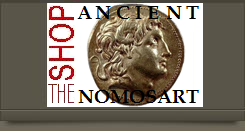
about ancient nomos
Ancient Nomos Art is a museum of galleries exhibiting ancient coins and ancient mint maps. The coin gallery displays the diverse art and history of hand-crafted ancient Greek, Roman, Byzantine, Persian and Medieval coinage. The ancient mints mapping gallery features Greek, Roman, Byzantine, Asia Minor and Medieval mint city regions and territories. Visitor's are welcome to explore, study and enjoy Ancient Nomos Art.

Baktrian Kingdom – 150 BC
Zoilos I Dikaios
From Ancient Galleries

Obverse: Diademed and draped bust of Zoilos I Dikaios facing right; Greek legend.
Reverse: Herakles standing facing, holding wreath, club and lion skin; Kharosthi legend.
LEGEND SYMBOLS
Obv: BAΣIΛEΩΣ ΔIKAIOY ZΩIΛOY, diademed and draped bust of Zoilos I Dikaios facing right. Rev: “Maharajasa dhramikasa Jhoilasa” legend in Kharosthi script. Nude figure of Herakles standing facing, holding wreath in partially raised right hand while cradling a raised club draped with lion skin over his left arm; monogram in left field.
The ancient Baktrian king Zoilos I Dikaios (his epithet means Zoilos “the Just”) was an Indo-Greek king who ruled in the Kingdom of Baktria (modern day Afghanistan and Pakistan), and occupied the areas of the Paropamisade and Arachosia previously held by Menander I. It is thought by many Numismatists that he may have belonged to the dynasty of Euthydemus I, as suggested by the coinage. In fact, Zoilos I was discovered and is known primarily through his vast Baktrian issued coinage. The coinage of Zoilos I uses a silver drachm type very similar to that of king Euthydemus II, son of the great Baktrian Demetrius. The typical reverse depicts a crowned Herakles standing, holding a wreath or diadem in his right hand, and a club and the lion skin in his left hand. On some of the coins, which are typically found in a lower state of artistic quality, Herakles is crowned by a small Nike. Zoilos I also struck rare gold-plated silver coins with portrait and Heracles. The Indian-standard coins of Zoilos I also bear the Pali title “Dhramikasa” (“Follower of the Dharma”), probably related to Buddhism, appearing for the first time on Indo-Greek coinage. A few monolingual Attic tetradrachms of Zoilos I have been found. Zoilos inherited (or took) several monograms from Menander I. His bronze coins are square and original in that they combine the club of Herakles with a Scythian-type of long bow scabbard (necessary to hold a short double curve bow) inside a victory wreath. This ancient Baktrian imagery suggested they had contacts or even perhaps an alliance with the horse-mounted people originating from the steppes territory, possibly either the Scythians (future Indo-Scythians), or the Yuezhi who had invaded Greco-Bactria. This type of bow can be contrasted to the traditional Hellenistic long bow depicted on the coins of the eastern Indo-Greek queen Agathokleia. Few drachms of Baktria are so exquisitely engraved as the specimen above, with a portrait of fine sculptural style and with a bold well-defined rendering of Herakles. This ancient Celators engraving is the work of a true master artist.
DOCUMENTATION
Value: Bilingual drachm. Metal: AR Silver. Weight: 2.44 grams. Mint: Baktria. Date: 150-130 BC.
Attribution: Mitchiner 140, Type 256b; Bopearachchi Série 3B; SNG ANS 968-972.
Legend, Documentation and Attribution
